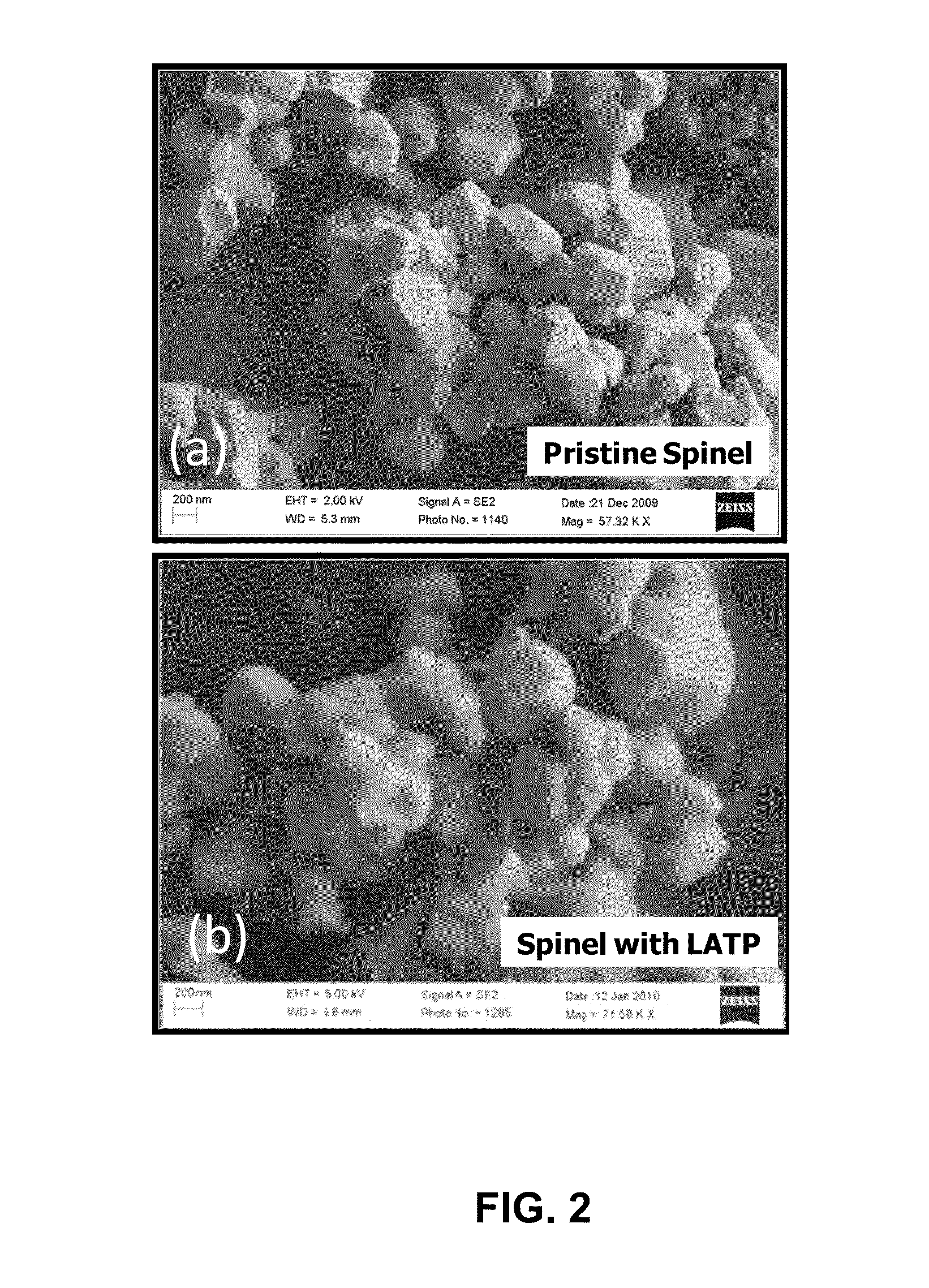High voltage cathode material for Li-ion batteries
a cathode material and high-voltage technology, applied in the direction of manganates/permanganates, nickel compounds, cell components, etc., can solve the problems of limiting the performance of practical applications, oxidizing the electrolyte, and limiting the easy ion transport, so as to improve the electrochemical performance of the naspinel, improve the electrochemical performance, and improve the effect of stability
- Summary
- Abstract
- Description
- Claims
- Application Information
AI Technical Summary
Benefits of technology
Problems solved by technology
Method used
Image
Examples
example 1
[0029]Nickel manganese oxide spinel was prepared by mixing 77.7 g of MnO2 and 22.3 g of NiO in dried Acetone. The mixture was dried at 120° C. for 12 hours, and heat treated at 900° C. for 5 hours to form Ni0.67Mn2O4 powder. In the second step, 18.4 g of Ni0.67Mn2O4 powder was mixed with 4 g of Li2CO3 and heat treated at 800° C. for 12 hours to form the final spinel material of composition LiMn1.5Ni0.5O4. As synthesized spinel had primary particle size of 0.3-0.5 micron with secondary particle size of less than 10 microns. The primary particle size refers to the size of the individual particle visible in an electron microscope image of the powder. The secondary particle size refers to the aggregate particle size, which is a collection of primary particles sintered together.
[0030]The LATP material with chemical formula of Li1.4Al0.4Ti1.6(PO4)3 was synthesized separately by mixing three solutions (labeled “A”, “B”, and “C”) through wet chemical process. Solution “A” was prepared by di...
example 2
[0036]A solid state process was used to synthesize the cathode material. 77.7 g of MnO2 and 22.3 g of NiO was mixed in dried Acetone. The mixture was dried at 120° C. for 12 hours, and heat treated at 800° C. for 5 hours to form Ni1−xMn2−xO4 (x≦0.33) spinel powder. In the next step, 18.4 g of Ni1−xMn2−xO4 powder was mixed with 4 g of Li2CO3 and heat treated at 800° C. for 12 hours to form the final spinel material. The results of XRD showed that the major phase in the powder was that of Ni1−xMn2−xO4 (x≦0.33) spinel. This suggests that phase pure spinel powder can be obtained by choosing an appropriate temperature that is greater than 800° C. but less than or equal to 900° C. The rest of the process was similar to that in Example 1.
example 3
[0037]The LATP solution was synthesized by mixing three solutions (labeled “A”, “B”, and “C”) through a wet chemical process. Solution “A” was prepared by dissolving 16.09 g of citric acid in 210 mL of de-ionized water followed by addition of 11.9 g titanium isopropoxide. The resultant mixture was refluxed for 4 hours to obtain a clear solution. Solution “B” was first prepared by addition of 9.1 g of citric acid to 183.7 mL of de-ionized water. After complete dissolution of citric acid, 2.5 g of LiNO3 and 9.1 g of NH4H2PO4 were added to the citric acid solution. Solutions “A” and “B” were mixed together for half an hour which was labeled as solution “D”. Solution “C” was prepared in 52.7 mL of de-ionized water by dissolving 9.1 and 4 g of Al (NO3)3 and citric acid, respectively. The final solution was obtained by mixing the two solutions “D” and “C” for half hour, followed by addition of 18.9 g of diethylene glycol (DEG). After completion of mixing, the pH was about 2.0 and the solu...
PUM
| Property | Measurement | Unit |
|---|---|---|
| thickness | aaaaa | aaaaa |
| thickness | aaaaa | aaaaa |
| voltage | aaaaa | aaaaa |
Abstract
Description
Claims
Application Information
 Login to View More
Login to View More - R&D
- Intellectual Property
- Life Sciences
- Materials
- Tech Scout
- Unparalleled Data Quality
- Higher Quality Content
- 60% Fewer Hallucinations
Browse by: Latest US Patents, China's latest patents, Technical Efficacy Thesaurus, Application Domain, Technology Topic, Popular Technical Reports.
© 2025 PatSnap. All rights reserved.Legal|Privacy policy|Modern Slavery Act Transparency Statement|Sitemap|About US| Contact US: help@patsnap.com



